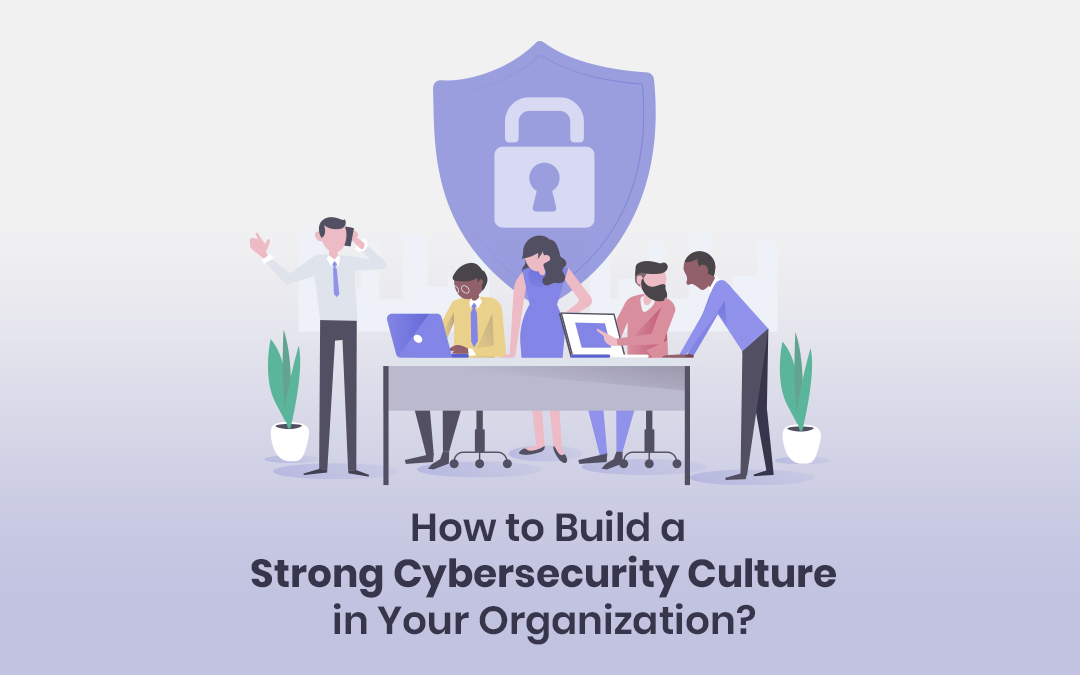
An effective cybersecurity culture is essential for any organization in an environment of digital threats. It's not just about having the right technology; it's about establishing an environment where every employee understands their role in protecting sensitive information. So, how to build a strong cybersecurity culture in your organization?
To build a strong cybersecurity culture, prioritize leadership commitment, continuous employee training, clear policies, open communication, and regular drills. Leverage technology, measure progress, and celebrate achievements to keep security a shared responsibility across the organization.
Want to know more about these? Let's explore the strategies to make this improvement happen.
What Does Cybersecurity Culture Mean?
Cybersecurity culture refers to the collective mindset and behaviors of an organization regarding security practices and protocols. It encompasses how employees perceive, prioritize, and respond to cybersecurity threats in their daily work. At its core, a strong cybersecurity culture promotes the idea that protecting sensitive information is everyone's responsibility, not just the IT department's.
In a healthy cybersecurity culture, employees feel empowered to speak up about security concerns and actively participate in safeguarding the organization’s data. This culture encourages open communication, ongoing training, and awareness programs to keep everyone informed about the latest threats and best practices.
When organizations prioritize a cybersecurity culture, they create an environment where employees are more vigilant and proactive. This leads to fewer security incidents and a stronger overall defence against cyber threats. A well-informed workforce can recognize phishing attempts, practice safe browsing habits, and understand the importance of secure passwords.
How to Build a Strong Cybersecurity Culture in Your Organization?
Building a strong cybersecurity culture within your organization is essential for safeguarding sensitive data and ensuring the integrity of your systems. A proactive approach to cybersecurity can reduce risks and create a sense of shared responsibility among all employees. Here’s a step-by-step guide to help you cultivate an effective cybersecurity culture.

Leadership Commitment
Establishing a strong cybersecurity culture starts at the top. Leaders must visibly support cybersecurity initiatives and prioritize them as an organizational value. This commitment should be communicated through regular updates, meetings, and strategic planning sessions. When leadership prioritizes cybersecurity, it sends a clear message that it is essential for the organization.
Assess Current Culture
Before implementing new strategies, assess the existing cybersecurity culture. Conduct surveys or interviews to assess employees' expertise and attitudes toward cybersecurity. Identify any knowledge gaps and areas for improvement. This assessment will provide a foundation for adjusting your initiatives to fit your organization’s specific needs.
Engage with External Experts
Consider collaborating with cybersecurity experts or consultants to improve your organization's efforts. They can provide valuable insights, resources, and tools that may not be available in-house. Attending industry conferences, such as upcoming conferences in Canada, allows you and your team to network with peers and explore new ideas and best practices.
Provide Ongoing Training and Education
Training is crucial for developing a strong cybersecurity culture. Offer regular workshops and seminars that cover various topics, such as phishing awareness, password management, and data protection strategies. Use a mix of formats—such as in-person sessions, online courses, and interactive simulations—to adapt to different learning styles. Regular training helps reinforce knowledge and keeps cybersecurity at the forefront of employees’ minds.
Encourage Open Communication
Create an environment where employees feel comfortable discussing cybersecurity concerns. Establish channels for reporting suspicious activities or incidents without fear of repercussions. Encourage feedback on security policies and practices, allowing employees to voice their opinions and suggestions. Open communication creates a sense of community and shared responsibility in maintaining a secure environment.
Implement Clear Policies and Procedures
Develop and disseminate clear cybersecurity policies that outline acceptable behavior, roles, and responsibilities. Ensure that employees understand these policies and the rationale behind them. Include guidelines on handling sensitive information, using personal devices, and reporting security incidents. Regularly review and update these policies to keep them relevant.
Utilize Gamification
Incorporate gamification techniques into your training programs to make learning about cybersecurity fun and engaging. Create quizzes, competitions, or simulations that encourage employees to practice their skills in a low-pressure environment. Rewards, such as recognition or small prizes, can motivate participation and reinforce positive behaviors.
Conduct Regular Simulations and Drills
Organize periodic cybersecurity training sessions to test employees' responses to potential threats. Simulations can include phishing attacks or data breaches to assess how well employees follow procedures and report incidents. Analyze the results and provide constructive feedback, focusing on areas for improvement. Regular practice prepares employees for real-life scenarios and helps them build confidence in their abilities.
Promote a Culture of Accountability
Encourage a culture of accountability by ensuring that all employees understand their role in cybersecurity. Highlight individual contributions to maintaining a secure environment, and recognize those who demonstrate exemplary behavior. Celebrate successes and learn from failures to create a culture where everyone feels responsible for security.
Leverage Technology for Support
Use technology to support your cybersecurity initiatives. Implement security tools that provide better protection and provide employees with real-time updates on potential threats. Encourage the use of password managers, multi-factor authentication, and secure communication platforms to make it easier for employees to follow best practices.
Measure Progress and Adapt
Continuously measure the effectiveness of your cybersecurity culture initiatives. Collect feedback through surveys and analyze incident reports to identify trends and areas for improvement. Use this data to adapt your strategies and ensure that they remain relevant to your organization's needs. Regular assessments will help you refine your approach and maintain a strong cybersecurity culture over time.
Celebrate Achievements
Recognize and celebrate milestones in building your cybersecurity culture. Whether it’s successfully completing training programs or achieving a lower incident rate, acknowledging progress develops a sense of pride and motivates continued commitment. Celebrations can be simple team gatherings, shout-outs in meetings, or highlighting successes in company newsletters.
Creating a strong cybersecurity culture takes time and effort, but the benefits are significant. By following these steps, your organization can cultivate an environment where cybersecurity is a shared responsibility, and employees feel empowered to contribute. A strong cybersecurity culture not only protects your organization’s data but also builds trust with clients and stakeholders, setting the stage for long-term success.
Benefits of Having a Strong Cybersecurity Culture
A strong cybersecurity culture is essential for any organization aiming to safeguard its sensitive data and systems. Beyond just compliance and protocols, creating this culture can yield numerous benefits that can improve both security and overall organizational health. Here are some key advantages of having a strong cybersecurity culture.
Increased Awareness and Vigilance
When employees understand the importance of cybersecurity, they become more aware of potential threats. Regular training and open discussions about risks encourage a proactive mindset. This heightened vigilance helps prevent security incidents before they escalate.
Reduced Risk of Human Error
Human error is often the weakest link in cybersecurity. A strong culture promotes best practices, like secure password usage and recognizing phishing attempts. With continuous education, employees are less likely to make mistakes that could compromise sensitive information.
Enhanced Incident Response
Organizations with a solid cybersecurity culture are better equipped to respond to incidents. Employees know the protocols and can act quickly, minimizing damage during a breach. This rapid response is crucial for protecting sensitive data and maintaining trust with clients and stakeholders.

Increased Collaboration and Communication
A strong cybersecurity culture encourages collaboration among departments. Open lines of communication about security threats and solutions improve teamwork. This collaborative spirit leads to innovative approaches to tackling cybersecurity challenges.
Boosted Employee Morale and Engagement
When employees feel responsible for their organization’s cybersecurity, it can significantly improve their job satisfaction. Being part of a culture that values security gives employees a sense of purpose and pride, contributing to higher morale and engagement levels.
Stronger Organizational Reputation
Organizations with a strong cybersecurity culture build trust with clients and stakeholders. A commitment to security reassures customers that their data is safe, enhancing your organization’s reputation in the market. This can lead to increased business opportunities and long-term success.
Compliance and Risk Management
A proactive cybersecurity culture helps organizations stay compliant with regulations and standards. When employees understand compliance requirements, it reduces the risk of legal issues and financial penalties associated with data breaches.
Building a strong cybersecurity culture not only protects your organization from threats but also creates a positive work environment, encourages collaboration, and improves your overall reputation. Investing in this culture is essential for long-term success in today’s digital landscape.
Basic Requirements to Build a Strong Cybersecurity Culture
Building a strong cybersecurity culture within an organization is essential for safeguarding sensitive information and enhancing overall security. Here are some basic requirements to help establish this vital culture.
1. Leadership Commitment
Top management must demonstrate a clear commitment to cybersecurity. When leaders prioritize security, it sets the tone for the entire organization. They should actively participate in discussions, provide resources, and lead by example, emphasizing the importance of cybersecurity.
2. Comprehensive Training Programs
Regular training sessions are crucial for educating employees about cybersecurity best practices. These programs should cover topics such as identifying phishing attempts, safe browsing habits, and the importance of strong passwords. Engaging and interactive training can improve the retention and application of knowledge.
3. Open Communication
Encouraging open communication about cybersecurity helps create a safe space for employees to ask questions and report concerns. Regular meetings or forums can facilitate discussions about potential threats and best practices, developing a sense of shared responsibility.
4. Clear Policies and Procedures
Establishing clear cybersecurity policies and procedures is essential. These guidelines should outline acceptable behaviors, incident reporting processes, and the consequences of non-compliance. Make sure these documents are easily accessible and regularly reviewed.
5. Regular Assessments and Updates
Conduct regular assessments of your cybersecurity posture to identify vulnerabilities and areas for improvement. Stay informed about emerging threats and update training programs and policies accordingly. This proactive approach helps maintain a strong security stance.
6. Recognition and Incentives
Recognizing employees who demonstrate good cybersecurity practices can reinforce positive behavior. Consider implementing an incentive program that rewards employees for reporting threats or completing training.
By implementing these basic requirements, organizations can cultivate a strong cybersecurity culture that not only protects sensitive information but also empowers employees to take an active role in safeguarding the organization.
Challenges to Face While Building a Strong Cybersecurity Culture
Building a strong cybersecurity culture within an organization is essential, but it also comes with its fair share of challenges. Here are some of the key hurdles organizations may encounter:
Employee Resistance
One of the most significant challenges is overcoming employee resistance to change. Many individuals may view cybersecurity measures as unnecessary or disruptive to their daily routines. Engaging employees and demonstrating the importance of cybersecurity in protecting both personal and organizational data can help mitigate this resistance.
Lack of Awareness
Many employees may not fully understand the importance of cybersecurity or the potential consequences of neglecting it. Bridging this knowledge gap requires consistent training and education. Organizations must create awareness campaigns that highlight real-life examples of cyber threats and their impacts.
Insufficient Resources
Building a strong cybersecurity culture often requires time, money, and resources. Smaller organizations, in particular, may struggle to allocate adequate funds for training, tools, and personnel. Prioritizing cybersecurity and integrating it into the organization’s budget can help address this challenge.
Rapidly Growing Threat Landscape
The cybersecurity landscape is constantly changing, with new threats emerging regularly. Keeping up with the latest trends and attack vectors can be overwhelming for organizations. Continuous training and a commitment to staying informed are essential to ensure employees are prepared for changing threats.
Fragmented Policies and Procedures
Organizations may struggle with inconsistent policies or a lack of clear procedures related to cybersecurity. This can lead to confusion among employees regarding their roles and responsibilities. Developing comprehensive, easily accessible policies is crucial for improving a unified approach to cybersecurity.
By recognizing and addressing these challenges, organizations can build a strong cybersecurity culture that empowers employees to take an active role in protecting valuable information and resources.
End Note
Creating a strong cybersecurity culture is not just a task; it’s an ongoing experience that shapes your organization’s future. Employees become your first line of defense when they feel empowered and informed. The right culture develops not just compliance but a shared commitment to security.
Recognizing how to build a strong cybersecurity culture in your organization involves engaging employees at all levels. Training and awareness initiatives can transform scepticism into proactive participation. When everyone understands their role, the organization becomes a fortress against cyber threats.
Nurturing this culture means prioritizing security as a core value. Investing in your team’s awareness and skills will protect your organization and promote a sense of pride in every member.
Share this post
Leave a comment
All comments are moderated. Spammy and bot submitted comments are deleted. Please submit the comments that are helpful to others, and we'll approve your comments. A comment that includes outbound link will only be approved if the content is relevant to the topic, and has some value to our readers.

Comments (0)
No comment